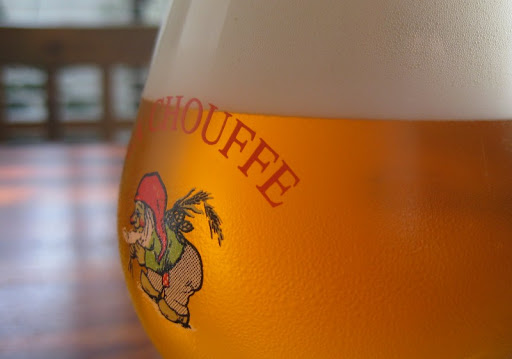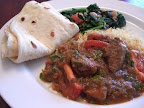Belgian Tripel IPA Partial Mash Recipe

There is a long history of American brewers being influenced by their Belgian counterparts, but lately the flow of ideas has been going the other way as well. In 2005, Hildegard van Ostaden was inspired by American IPAs and decided to brew a Tripel with an American IPA hop profile. The result was Urthel Hop-It, and it was very good indeed.
Our first exposure to this style was a Houblon Chouffe Dobbelen IPA Tripel at the Liars' Club, and we were instantly fans. Two of our favorite beer styles are the IPA and the Belgian Tripel, so it is no surprise that a combination of the two is right up our alley.
In the past few years, American brewers have begun to adopt the style as well. Here in San Diego, Green Flash's excellent Le Freak has been getting better with each year they brew it. We decided it was time to get in the game and try to brew one of our own, so we scoured the internet for information and cobbled together a recipe.
Tripels are generally higher octane than IPAs (and most double-IPAs). For our Tripel IPA we were shooting for an original gravity of about 1.082, which a lot of fermentable sugars. Going with the Tripel style, we used Pilsner malt supplemented with clear candi sugar to get the high gravity while keeping a light color and body.
Candi sugar has very large, nearly half-inch crystals. This is what it looks like:

Given the amount of fermentables, we decided to get things going with a two-cup yeast starter culture to give things a kick-start. And man did it ever kick-start. The next morning the wort was moving around like crazy and bubbling so hard it sounded like a motor running.
Fortunately, it didn't quite overflow the air-lock, so we didn't have a mess to clean up.
The resulting ale turned out very well - golden in color and full of flavor. The distinctive Belgian yeast character is balanced very nicely by the aroma and bitterness of the hops. Apparently our yeast was very happy since we achieved a higher level of conversion than expected - with an ABV of 9.2%, it packs quite a punch. Definitely not a session beer...

Belgian Tripel IPA
Total batch size = 5 gallons; Partial Mash in 3 gallon beverage cooler; ~3 gallon 60 minute stove-top boil; late malt extract addition; dry hopped for aroma; target abv of 8.5%
5 1/2 lb Pilsner Malt (Belgian)
1/2 lb Wheat Malt
5 lb Briess Pilsen Dry Malt Extract (DME)
1 1/2 lb Candi Sugar, Clear
2 oz Columbus Hops (12.3% AA)
1 1/2 oz Saaz Hops (4.0% AA)
1 oz Amarillo Hops (8.5%)
1 tablet Whirlfloc
White Labs WLP550 Belgian Ale Yeast
4 oz corn sugar (optional - for bottle priming)
2 1/2 oz light or pilsen DME, plus 1 T cane sugar (optional - for starter culture)
1/2 oz Columbus - 60 minutes boil
1/4 oz Columbus - 45 minutes boil
1 1/2 oz Saaz - 15 minutes boil
1/4 oz Columbus - 10 minutes boil
1/2 oz Columbus - 0 minutes boil
1/2 oz Columbus - Dry Hop in Secondary Fermenter
1 oz Amarillo - Dry Hop in Secondary Fermenter
[Optional: Prepare a starter culture the day before brewing. Heat 2 cups water then add 2 1/2 oz DME and 1 tablespoon sugar. Boil 10 minutes, then cool quickly to room temperature. Put into a sanitized 1 quart jar or bottle, add yeast, seal and shake gently for 30 seconds. Loosen the lid or use an air-lock to allow gases to escape and let sit until time to pitch the following day.]
Heat 8.25 quarts water to 165 degrees for a target mash temperature of 150-153 degrees. Place the 6 pounds of crushed grain (Pilsner and Wheat) into a large mesh bag. Pour the hot water into the beverage cooler, then lower the grain bag into the water very slowly, pushing and prodding with a large spoon to ensure all the grain is wet (this can take several minutes). Put the lid on the cooler and allow to rest 60 minutes.
While the grains are mashing, heat another 4-5 quarts of water to 180-185 degrees for sparging (rinsing the grains). Near the end of the 60 minutes, heat 2 quarts of water to a boil in your brew pot.
After the first mash is complete, remove the cooler lid and open the spigot to draw off about 2 quarts of wort into a large pitcher. The first draw will likely be cloudy with grain particles; pour it gently back into the cooler over the grain bag to help filter it. Draw off the remaining wort by the pitcher-full and carefully pour that wort into the boiling water in your brew pot; continue until only a trickle of wort leaves the spigot.
Pour about 4 quarts of your hot sparge water over the grain bag in the cooler. Gently lift the bag up and down to thoroughly re-wet the grains (but don't slosh). Cover and let sit about 5 minutes. Use the spigot and a pitcher to draw off all of the second wort and add it to your brew pot. You should have about 3 gallons of wort.
Dissolve the candi sugar in the hot wort, being careful to keep the sugar from scorching. You can do this easily by suspending the crystals in a strainer or chinois as you bring the liquid to a boil. When ready, add hops according to the schedule. With about 15 minutes remaining in the boil, begin adding the DME one cup at a time, stirring to dissolve. At time zero, continue adding DME off the heat until all has been added (if needed, return to low heat for a few minutes to help dissolve the extract). Stir in 1 tablet Whirlfloc. Cover and let sit 10-15 minutes.
Move brew pot to an ice bath and cool quickly to less than 80 degrees. Transfer wort to a primary fermenter, straining most of the hops. Add water to reach the 5 gallon mark. Swirl vigorously then pitch the yeast.
Ferment in primary for 1 week, then transfer to secondary. After seven days, dry hop with 1/2 oz Columbus and 1 oz Amarillo. Keg or bottle after fermentation is complete (2 to 3 weeks in secondary).







What temperature do you keep this at for primary and secondary?
ReplyDeleteHi Robin - We don't do anything special to control our temps other than keep it warm enough at night during primary (over 70F). When we made this one, room temp was around 74 degrees F during the day for both fermentations.
ReplyDeleteUS Gallon or UK Gallons? I need to know to convert in liters
ReplyDeleteUS Gallons.
ReplyDeleteThanks Mike.
ReplyDeleteAnother question, we boil the entire recipe volume (5 gallons)?
Sorry but i have not done all the conversions
Thanks from Italy
No - water gets added after the boil to reach the final 5 gallon volume.
ReplyDeleteI'm just getting into homebrewing and am very excited about trying this recipe. One question though, did you need to add any priming sugar for carbonation before bottling?
ReplyDeleteHi Nate - we primarily keg our beer these day, but we did do a few bottles of this batch. We used priming sugar as we normally would, and the carbonation was fine.
ReplyDeleteGreat Recipe! Mine is in secondary and already tastes great. One thing though - when I brewed this one it popped the lid on the fermenter (fermenting at about 70 degrees F.). I'd suggest a blow off hose instead of a airlock for something with this much fermentable sugar. Thanks for the inspiration. A slight variation of your RyePA recipe is on deck for tomorrow!
ReplyDeleteHi Greg, Yes, a blow off hose is a good idea for this one. As an alternative, you can use an anti-foam agent (Fermcap-S) to help avoid fermentation blow-overs. It's made so that it prevents bubble formation during high activity, but settles out into the trub when it's calm.
ReplyDeleteFor high gravity beers, we usually put a few drops of anti-foam into the fermenter and another couple drops right into the air-lock. It works great.
Glad you're enjoying the recipes!
Brewed this up for a commemorative baby brew in honor of my newborn son. This is one of the few beers I have brewed that turned out exactly like I had hoped on the first try. Excellent. A perfect marriage between the yeast and hops. Thanks for posting.
ReplyDeleteAlways nice to hear that one of our recipes worked well for someone - we need to make another batch of this soon.
ReplyDeletewe just racked this a few days ago (and the imperial today) and they both seem great. I agree, the step by step instructions have really been great, although a bit confusing the first read-thu. I would also suggest you make a edit with the air lock/foaming agent for your future readers - ours had a minor blow out, but all was not lost.
ReplyDeletethanks again for the great recipies. I won't lie, the pictures you folks post of final product and process are really the ticket.
much love and live it up
tucker louisos-daniels
portland, maine, usa.
Hi Tucker - glad you have found the recipes useful. Enjoy the beers!
ReplyDeleteHi Mike,
ReplyDeleteI brewed your recipe a couple of months ago and just popped one open last week. Great job! I never had this style before but it married two of my preferred beer styles together. I will definitely keep this recipe on hand and experiment a little more with it. Thanks!
Hi Brian - if you tweak the recipe, definitely let us know what you did and how it turned out.
ReplyDeleteHi guys, I followed your recipe a bit ago, and have been drinking it for the last few weeks. And oh man! Definitely the best I've made, and one of the best tripel-ipa combos I've ever had (better than the Houblon and Le Freak in my opinion). I plan on making it again, and getting a little more aggressive with the hops; I'll let you know how it turns out. Thanks!
ReplyDeleteHi Hunter - glad you liked it!
ReplyDeleteDamn good recipe. Bottled and drinking after 3 weeks. Tasty and an easy drink. Thanks.
ReplyDeleteComparing with the taste of houblon chouffe ipa tripel, how close was it? Were the hop characteristics matching? Trying to figure out the recipe. Thanks for the help! Houblon is a damn good beer.
ReplyDeleteThis beer wasn't really an attempt to clone Chouffe, or any other specific Belgian Tripel.
DeleteJust put this into my secondary, took a reading with my hydrometer of 1.015, What was your Terminal gravity reading?
ReplyDeleteWe had a final gravity of 1.014 - almost exactly the same as yours.
Deletemy efficiency was a little low (og 1075), only got 8% out of it. It sat for 3.5 weeks in secondary since I didn't have any whirfloc on hand during boil. Came out nice and clear. I just bottled it adding priming sugar, but do you think the yeast sit too long in "high" abv, am I goign to carb up enough? either way it tasted great going into the bottle.Thanks!
DeleteWe haven't bottled in a while - and never that beer, so I don't really have any advice other than to cross your fingers and hope for the best!
Deletecarbed up perfectly. Would definitely suggest a bit more late addition hops (at least on my system) and should have waited a week to dry hop as sitting for the 3rd week it lost alittle on the nose. all in all very happy with my first truly successful batch. Thanks for the recipe!
ReplyDelete